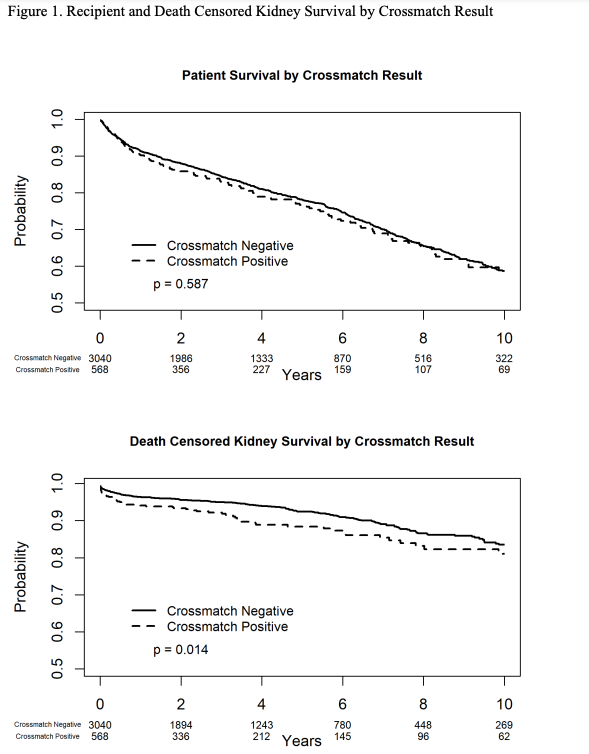Crossmatch positive status does not impact long term outcomes in simultaneous liver kidney transplants
Elizabeth Aby 1, Scott Jackson2, Phuoc Le Nguyen3, John Lake1, Samy Riad4.
1Hepatology , University of Minnesota, Minneapolis, MN, United States; 2Complex Care Analytics , MHealth Fairview , Minneapolis, MN, United States; 3Surgery , University of Minnesota, Minneapolis, MN, United States; 4Nephrology , University of Minnesota, Minneapolis, MN, United States
Background: We recently examined the association between strongly positive crossmatch status and outcomes of simultaneous liver-kidney recipients (SLK)1. Herein, we examine the association between positive crossmatch (XM) status of any capacity (weakly positive, T-cell, B-cell or both positive) and SLK outcomes in recipients discharged on a standardized immunosuppression regimen of tacrolimus and mycophenolate with or without steroids.
Methods: We analyzed the SRTR standard analysis file for all primary SLK recipients between 2003 and 2020 with available XM and induction regimen data. According to the XM status, recipients were grouped: crossmatch negative (XM-) N=3040 and XM+ (of any capacity) N=568. Kaplan-Meier curves were generated to examine recipient, death-censored liver and kidney survival by XM status. Cox proportional hazard models were used to investigate the association between XM status and outcomes of interest with follow-up censored at ten years. Models were adjusted for recipient age, sex, MELD scores, duration on the liver waitlist, induction immunosuppression, steroid maintenance, hepatitis C virus status, donor age and sex, local vs. shared organ status, liver and kidney cold ischemia time and previous liver transplant status.
Results: In the univariable analysis, XM status was not associated with recipient survival (log-rank p=0.59) or death-censored liver graft survival log-rank (log-rank p=0.014). Death-censored kidney graft survival, however, was slightly lower in the XM+ group (log-rank p=0.014). In the multivariable models, XM+ status was not associated with deleterious long-term recipient, liver graft, or kidney graft survival (p=0.78, p=0.15, and p=0.20, respectively).
The 1-year liver rejection rate did not differ between XM+ and crossmatch negative (XM-) groups. The 1-year kidney rejection rate in the XM- group was lower than their counterparts (4.6% vs. 9.1%, P< 0.001), but the 1-year serum creatinine did not differ significantly between XM+ and XM- groups (p=0.23).

Conclusion: Although the kidney rejection rate is slightly higher in SLK recipients with XM+, the 10-year recipient, liver and kidney survival censored for death was not influenced by crossmatch staus in the multivariable models.
Reference:
1. Riad S, Aby ES, Nguyen PL, Jackson S, Lim N, Lake J. Long-Term Outcomes of Crossmatch Positive Simultaneous Liver Kidney Transplants in the Unite
The data reported here have been supplied by the Hennepin Healthcare Research Institute (HHRI) as the contractor for the Scientific Registry of Transplant Recipients (SRTR). The interpretation and reporting of these data are the responsibility of the author(s) and in no way should be seen as an official policy of or interpretation by the SRTR or the U.S. Government.

right-click to download
